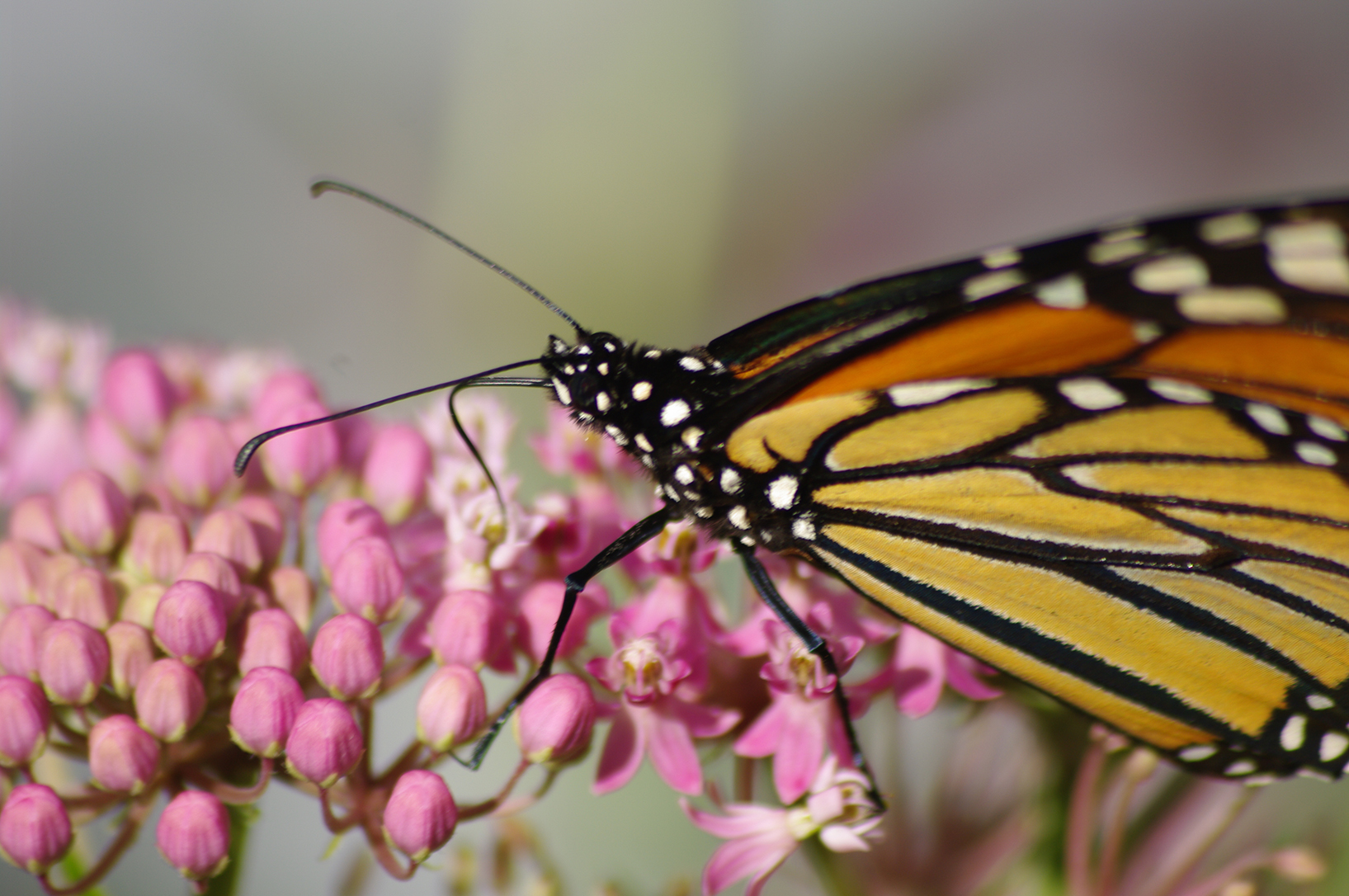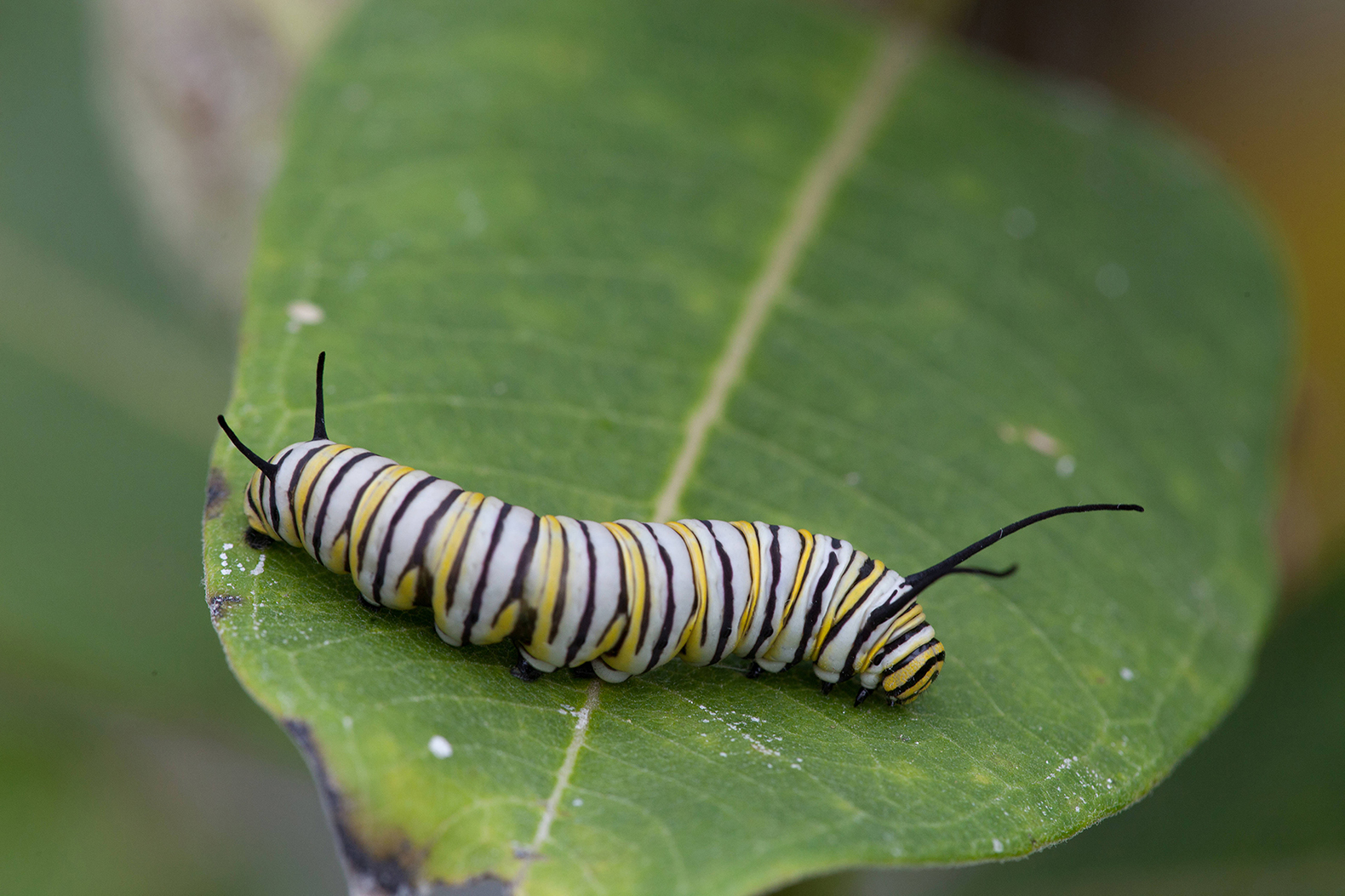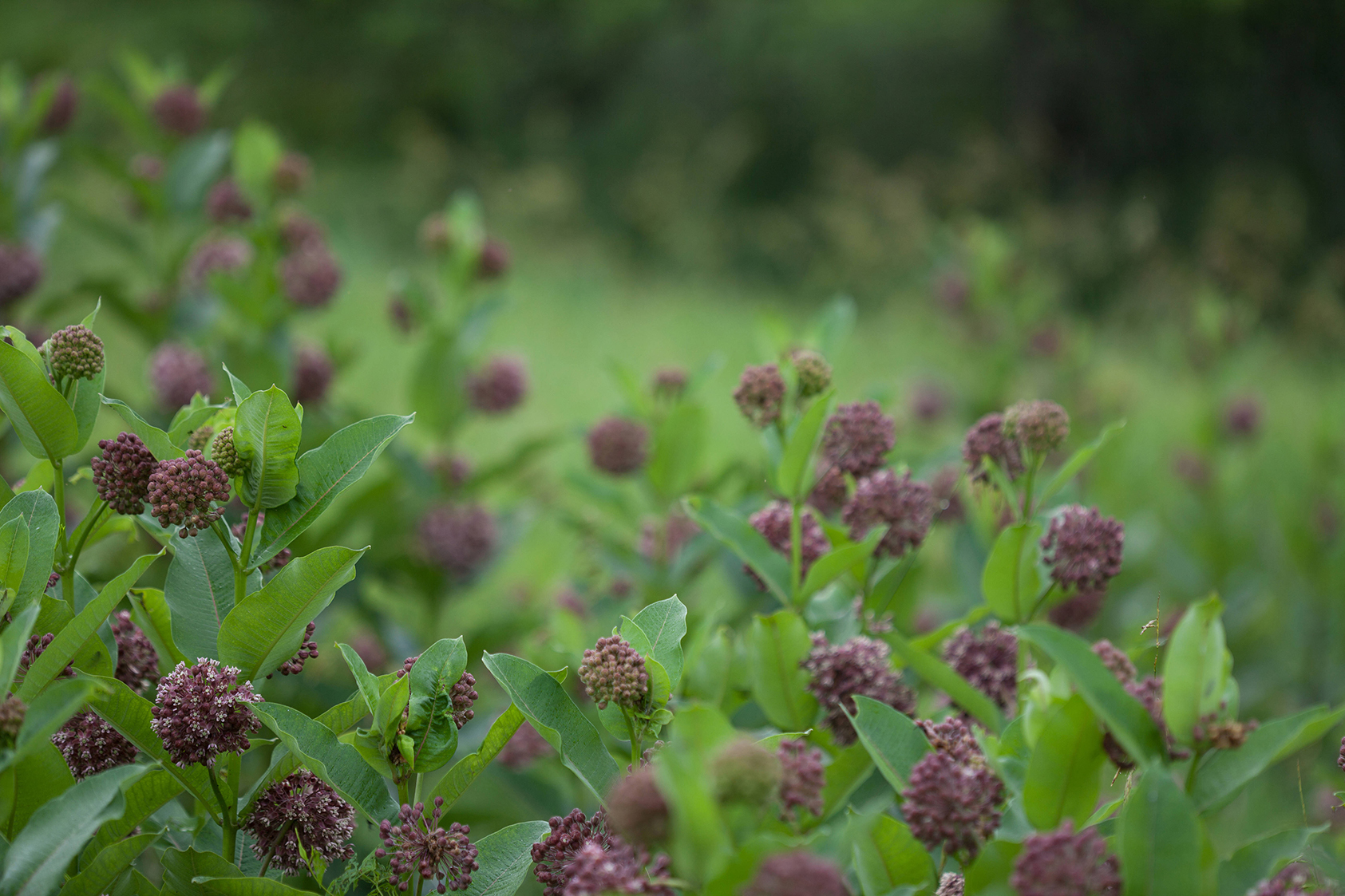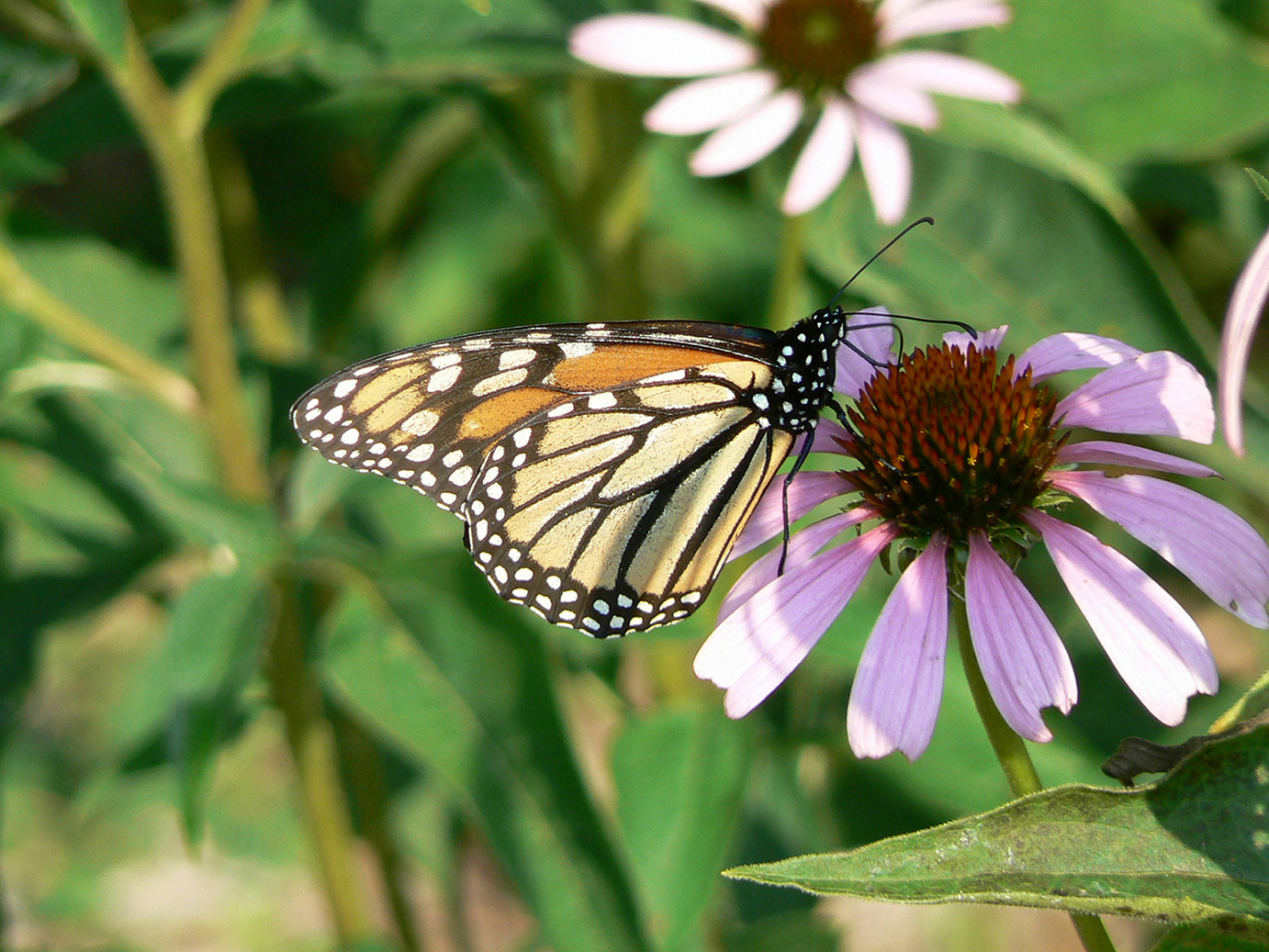Monarch butterflies winging their way north to Michigan
Several efforts under way to bolster declining populations
With spring now sprung in Michigan, soon we’ll be welcoming back to the state one of the most distinctive signs that summer is on its way – the brightly colored monarch butterfly.
Monarchs are on their way north from Mexico, where they spend the winter months. While National Start Seeing Monarchs Day is observed annually on the first Saturday in May, it may be a few more weeks before they make their way across Michigan.
 One of the most well-known and beloved butterfly species in North America, with their easily recognized orange and black wing pattern, monarchs have become a much less common sight in recent decades. One of the most well-known and beloved butterfly species in North America, with their easily recognized orange and black wing pattern, monarchs have become a much less common sight in recent decades.
The eastern monarch butterfly population has declined by 90 percent over the last 20 years due mainly to habitat loss, both in their summer range – including Michigan – and in Mexico, where they overwinter.
“Because of the tremendous migration they make, monarchs need a variety of habitats,” said Dan Kennedy, Michigan Department of Natural Resources endangered species coordinator. “In the early summer, they lay their eggs on milkweed because that’s the only plant their caterpillars will eat.
“Monarchs also need habitat to overwinter in, not to mention habitat where they can stop and refuel along the way. They are very active insects and require a wide variety of flowering plants to provide the food they need to survive and make their long journey.”
Scientists monitor the eastern overwintering population of monarch butterflies in Mexico. This year’s population reports indicate that monarch butterflies continue to decline, according to the U.S. Fish and Wildlife Service.
The forest area the eastern monarch population occupied decreased 27 percent from winter 2015-2016, due to a series of severe storms.
“This year’s population numbers accentuate how imperative it is for our countries to continue working together to protect and conserve this amazing species – as well as the role every person plays in ensuring a future filled with monarchs,” said Tom Melius, U.S. Fish and Wildlife Service Midwest regional director and the service’s lead for the Monarch Butterfly Conservation Initiative.
 “It will take all of us working together in city backyards and across vast agricultural acres, to reverse this population decline.” “It will take all of us working together in city backyards and across vast agricultural acres, to reverse this population decline.”
Monarchs are pollinating insects that travel to flowering plants, drinking nectar and transporting pollen.
They’re not the only pollinators on the decline – bee populations worldwide also have decreased dramatically in recent decades, and the rusty patched bumble bee recently was listed as an endangered species.
“Pollinators, like butterflies and bees, are responsible for approximately one-third of the world’s food source,” said Kennedy. “Because of the important role pollinators play in people’s lives, it is up to us to help keep these pollinator populations abundant and healthy.”
The alarming declines in monarchs and other pollinators have sparked conservation programs across the nation.
Kennedy said the DNR has been working with the Midwest Association of Fish and Wildlife Agencies to develop a regional monarch conservation strategy that will cover key breeding and migration habitat across 16 states.
In addition, the DNR and more than 25 partners in the state have been working to develop Michigan’s Monarch and Wild Pollinator Strategy.
The Michigan Farm Bureau, the state’s largest general farm organization, is one of the key partners in the strategy to conserve monarch butterflies.
“Michigan’s farmers recognize the importance of both native and managed pollinators to support our state’s incredible diversity of crop production,” said Laura Campbell, manager of Michigan Farm Bureau’s Ag Ecology Department. “We help support farmers in this interest.”
The Michigan Department of Agriculture and Rural Development has developed a Protection Plan for Managed Pollinators in Michigan, which is our state’s response to the national strategy to protect managed pollinators from pesticide risk.
In addition to partnering with other agencies on both a pollinator protection plan for pesticide management and a monarch and native pollinator habitat plan, the Michigan Farm Bureau also encourages farmers to take advantage of technical assistance and cost-share programs available through the U.S. Department of Agriculture.
These programs have helped farmers establish almost 10,000 acres of pollinator habitat across nearly 500 farms, according to the USDA.
“We look forward to continuing our support of farmers’ efforts to implement smart, strategic and effective pollinator protection practices across the state,” Campbell said. “These efforts will help both pollinator populations and the success of Michigan’s farms.”
The DNR also is undertaking projects to enhance habitat for monarchs and other pollinators on land it manages.
Sleepy Hollow State Park in Clinton County, for example, has had a Monarch Waystation – a place, officially designated by Monarch Watch, that provides resources necessary for monarchs to produce successive generations and sustain their migration – in place since 2011.
 About an acre in size, the waystation was planted through a cooperative effort of the Friends of Sleepy Hollow, the Clinton County Soil Conservation District and the DNR. About an acre in size, the waystation was planted through a cooperative effort of the Friends of Sleepy Hollow, the Clinton County Soil Conservation District and the DNR.
Sleepy Hollow also is planning a larger pollinator habitat improvement effort of more than 20 acres. Still in its infancy, this project will use the gas line right-of-way that bisects the northern part of the park property.
Tim Machowicz, unit supervisor at Sleepy Hollow State Park, said of the planned habitat improvement, “The win is on multiple levels – more pollinator habitat, better use of what is presently land with limited wildlife value, and less work for Consumers Energy to maintain the right-of-way.”
There are many ways that Michigan residents can contribute to ongoing monarch conservation efforts as well. Creating habitat for monarchs and other pollinators, whether it’s in your backyard or a large field, is a great place to start.
“Monarch habitat includes several species of milkweed and multiple flowering plants that bloom throughout the spring, summer and fall,” Kennedy said. “Milkweed is important as a food source for monarch caterpillars, and flowering plants provide food for adults during migration and breeding.”
Kennedy stressed that it’s important to use plants that are native to Michigan so invasive species are not introduced into the state. More information about native plants is available from the Michigan Native Plant Producers Association.
Ten milkweed species are native to Michigan – the most widespread are common milkweed, butterfly milkweed and swamp milkweed.
According to Duke Elsner of Michigan State University Extension, milkweeds can be started from seeds – which can be collected from existing plants or purchased from commercial suppliers – or as young container plants.
Older milkweed plants are very difficult to transplant, so that approach isn’t recommended. Seeds need a three-month period of exposure to cold, so it is a good practice to plant seeds in autumn.
Container plants can be planted in spring, but it is advisable to wait until the threat of spring frosts has passed. Elsner provides more helpful tips in “Growing milkweeds for monarch butterflies.”
In an excerpt from “Smart gardening to support monarchs,” Elsner writes: “The adult monarch butterfly can feed on the nectar of many species of flowering plants. As they travel throughout Michigan from May through October, select flowers with a wide range of blooming times to support monarchs. You should have something blooming throughout the growing season. A series of blooming plants will also benefit many species of pollinating bees and natural enemies of pests.
“Some of the trees, shrubs and other plants monarch butterflies visit for nectar include wild cherry, lilac, Labrador tea, blazing star, red clover, dogbane, goldenrods, ironweeds, joe-pye weed, marigolds, asters, rattlesnake-master, sunflowers, thistles, vetches and milkweeds.”
Other resources include the Create Habitat for Monarchs web page from Monarch Joint Venture and “How to build a butterfly and pollinator garden in seven steps” from the U.S. Fish and Wildlife Service.
Another way you can contribute to monarch butterfly conservation efforts is to monitor monarch populations by reporting any sightings at Journey North or getting involved in other monarch citizen science opportunities.
“Much of what we know about monarch biology, migration, and conservation is informed by data collected by citizen scientists throughout North America” said Karen Oberhauser, founder of the Monarch Larva Monitoring Project and co-chair of the Monarch Joint Venture.
 The Monarch Conservation Science Partnership is looking for volunteers to participate in its national monitoring effort by collecting data, testing field techniques and providing feedback on the monitoring program. The Monarch Conservation Science Partnership is looking for volunteers to participate in its national monitoring effort by collecting data, testing field techniques and providing feedback on the monitoring program.
A free training session for volunteers will be held at Fenner Nature Center in Lansing, Michigan, on June 10-11. Register for the training.
Learn more about what you can do to help pollinators in Michigan, monarch biology, current projects helping pollinators, and activities and resources for kids and teachers by visiting michigan.gov/wildlife and clicking on “Monarchs in Michigan.”
Check out previous Showcasing the DNR stories and subscribe to upcoming articles.
/Note to editors: Contact: John Pepin 906-226-1352. Accompanying photos are available below for download and media use. Suggested captions follow. Credit: Michigan Department of Natural Resources, unless otherwise noted.
Butterfly 1-3: A monarch butterfly is shown.
Caterpillar: A monarch butterfly caterpillar on common milkweed. (U.S. Fish and Wildlife Service photo)
Container: Common milkweed plants growing in containers. (U.S. Fish and Wildlife Service photo)
Egg: A close-up view of a monarch butterfly egg. (U.S. Fish and Wildlife Service photo)
Larvae: Monarch butterfly larvae feeding on milkweed. (U.S. Fish and Wildlife Service photo)
Logo: The Monarchs in Michigan logo.
Milkweed: Common milkweed plants growing in the field. (U.S. Fish and Wildlife Service photo)
Monarch: A monarch butterfly is shown on a flower. (U.S. Fish and Wildlife Service photo)
Mother: A mother and daughter enjoy looking at a monarch butterfly on a flower. (U.S. Fish and Wildlife Service photo)
Sign: A sign marks a Monarch Waystation./
The Michigan Department of Natural Resources is committed to the conservation, protection, management, use and enjoyment of the state’s natural and cultural resources for current and future generations. For more information, go to www.michigan.gov/dnr.
|

 One of the most well-known and beloved butterfly species in North America, with their easily recognized orange and black wing pattern, monarchs have become a much less common sight in recent decades.
One of the most well-known and beloved butterfly species in North America, with their easily recognized orange and black wing pattern, monarchs have become a much less common sight in recent decades. “It will take all of us working together in city backyards and across vast agricultural acres, to reverse this population decline.”
“It will take all of us working together in city backyards and across vast agricultural acres, to reverse this population decline.”
 About an acre in size, the waystation was planted through a cooperative effort of the Friends of Sleepy Hollow, the Clinton County Soil Conservation District and the DNR.
About an acre in size, the waystation was planted through a cooperative effort of the Friends of Sleepy Hollow, the Clinton County Soil Conservation District and the DNR.
 The Monarch Conservation Science Partnership is looking for volunteers to participate in its national monitoring effort by collecting data, testing field techniques and providing feedback on the monitoring program.
The Monarch Conservation Science Partnership is looking for volunteers to participate in its national monitoring effort by collecting data, testing field techniques and providing feedback on the monitoring program.




